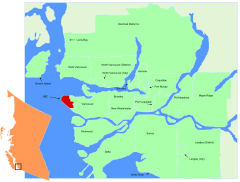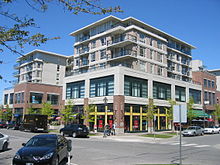University Endowment Lands
| University Endowment Lands | |
|---|---|
| State : |
|
| Province : | British Columbia |
| Regional District : | Metro Vancouver |
| Coordinates : | 49 ° 15 ′ N , 123 ° 14 ′ W |
| Height : | 80 m |
| Area : | 14.13 km² |
| Residents : | 7816 (as of: 2001) |
| Population density : | 553.1 inhabitants / km² |
| Time zone : | Pacific Time ( UTC − 8 ) |
| Postal code : | V6S - V6T |
 Location in the Metro Vancouver area |
|
The University Endowment Lands (German university foundation land , also known as University Hill or UEL ) are a community-free area west of the Canadian city of Vancouver , around the campus of the University of British Columbia (UBC). They are on the Georgia Strait at Point Gray, the westernmost point of the Burrard Peninsula . The UELs are part of the Greater Vancouver Electoral Area A and are jointly administered by the University, Metro Vancouver and the Province of British Columbia . About half of the area consists of the largely forested Pacific Spirit Regional Park . On the coast there are steep cliffs that rise up to 70 meters above the beaches.
history
The formation of the University Endowment Lands was first proposed after the University Endowment Act went into effect in 1907. The provincial government of British Columbia had committed to sell or lease an area of 8,000 km² to help build the university. This area was in the Cariboo region inland and was mainly used for agriculture. In 1911, the University Site Act came into force, giving the university an area of around 70 hectares.
In 1920 it turned out that the market value of the land in the Cariboo region was not high enough to generate enough income for the university. This led to the British Columbia University Loan Act , which gave the lieutenant governor the right to sell 30 km² of state-owned land near Point Gray for housing development. The profits made were used to further expand the university. However, a large part of the planned construction projects could not be implemented due to the global economic crisis . The university did not have enough money to clear the area and prepare it for development and passed responsibility back to the provincial government.
In the mid-1950s, over half of the land in the UEL was still undeveloped. Further construction projects failed due to resistance from environmentally conscious residents. In 1988, Provincial Prime Minister Bill Vander Zalm announced the creation of the Pacific Spirit Regional Park. The new park takes on the function of a green belt between the built-up part of the UEL and the city of Vancouver. Very strict building regulations are now in force. New construction projects can only be carried out after several stakeholders have been consulted beforehand. These are university students, university staff, faculty, various environmental groups, businesses, local residents and the general public.
administration
As a non-parish area, the UEL has no mayor or city council. Instead, the area is jointly managed by the University of British Columbia, the Metro Vancouver Region, and the Province of British Columbia . The campus, the Pacific Spirit Regional Park and the rest of the UEL are part of the Greater Vancouver Electoral Area A . Taxes are paid directly to the provincial government. Students living on the university campus are not subject to tax.
In contrast to neighboring Vancouver, the Vancouver Police Department is not responsible for security in the UEL , but a department of the Royal Canadian Mounted Police . However, the fire department of Vancouver is responsible for fire fighting .
Economy and Transport
The UEL are primarily a residential zone and practically all companies are service providers in the gastronomy, retail and health sectors. Most of these are located on the university campus as well as in the University Village and the University Marketplace. In addition, there are several museums and theaters such as the Belkin Art Gallery, the Museum of Anthropology , the Fredric Wood Theater and the Chan Center. Additional points of interest include the UBC Botanical Garden and the Nitobe Memorial Garden .
The Vancouver area is the third largest film and television series production center in North America. For this reason, many scenes that take place at a university are shot on the premises of the UBC. Companies that want to shoot recordings are required to pay a fee that is used to fund the film and theater faculty. The best-known productions that were shot at the UEL include Smallville , Startup , 4400 - Diereturner , Butterfly Effect , She's the Man - Voll mein Typ! , All I Want , Taken and The Exorcism by Emily Rose .
Since Pacific Spirit Regional Park delimits the area to the city of Vancouver, only five streets lead to the UEL and the university: North West Marine Drive, 4th Avenue / Chancellor Boulevard, 10th Avenue / University Boulevard, 16th Avenue and South West Marine Drive. However, the university campus is the terminus of 15 TransLink bus routes and students can take advantage of inexpensive bus subscriptions. There are plans to extend the SkyTrain's Millennium Line here.
Education and sport
In addition to the University of British Columbia , the UEL also houses the Vancouver School of Theology and Regent College . Two schools are available for residents in the 39 Vancouver School District. Most of the sports facilities in the UEL are located on campus. The university's sports teams are called UBC Thunderbirds . The War Memorial Gym, Thunderbird Stadium, UBC Aquatic Center, and Thunderbird Winter Sports Center are at your disposal.
With a view to the 2010 Olympic Winter Games , the Thunderbird Winter Sports Center was replaced by a new building, the Doug Mitchell Thunderbird Sports Center (other name: UBC Winter Sports Center). The new building has three ice rinks, the largest with a capacity of 7500 spectators. Several games of the Olympic ice hockey tournament are played here. The demolition of the old hall began in April 2006, the new hall was opened in September 2008.
Web links
Individual evidence
- ↑ Blog page of the "UBC Sky Train Group"
- ↑ a b UBC press release of August 21, 2009 ( memento of the original from October 1, 2009 in the Internet Archive ) Info: The archive link was automatically inserted and not yet checked. Please check the original and archive link according to the instructions and then remove this notice. to be renamed "Doug Mitchell Thunderbird Sports Center".
- ↑ 6800 spectators during the games, see Sports Venues Vancouver 2010: UBC Thunderbird Arena




